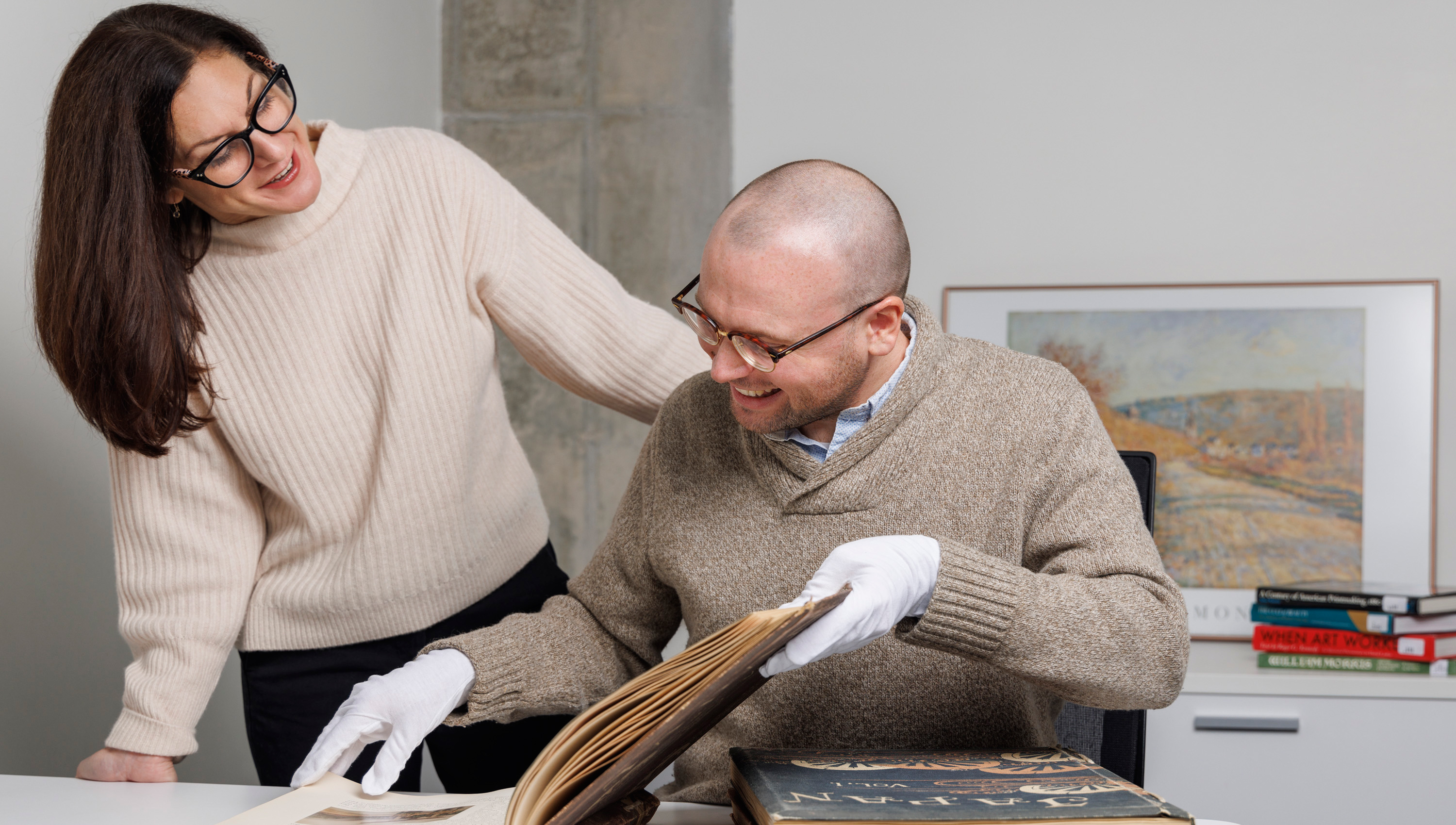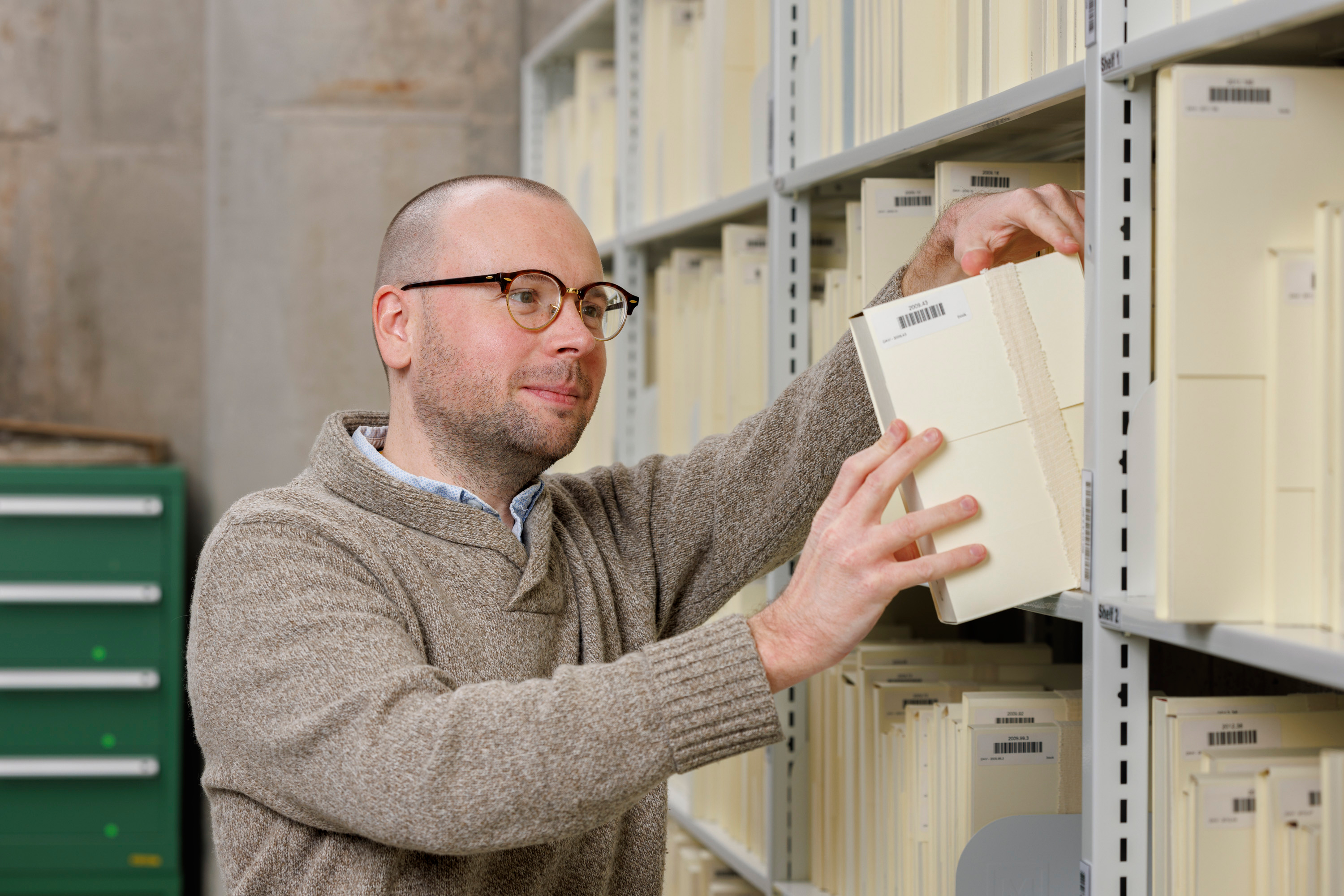Provenance Research at the DAM
“Provenance” is information about an artwork’s history of ownership and research into provenance reveals an object’s journey from its creation to the Denver Art Museum. Provenance research proves authenticity and legal ownership and is an important part of storytelling about the object, the artist or culture, the collectors who owned it, and collecting tastes of the time. Research sources include not just the object and museum records, but review of an artist’s known artworks, academic scholarship, and exhibition and publication history. Dealer, collector, auction, and photo archives can contain helpful ownership information, as can newspaper articles, obituaries, ancestry websites, red-flag lists and lost art databases. Gaps in provenance are common and can be attributed to information lost to time, lack of record keeping, natural disasters, war, or can even suggest a troubling or potentially illegal aspect of an object’s journey that is cause for further research.
Provenance research is an important part of the Denver Art Musem’s due diligence and best practices as a collecting institution. U.S. law, conventions regarding cultural property, and professional guidelines by the American Alliance of Museums (AAM) and the American Association of Art Museum Directors (AAMD) all help guide the museum’s legal and ethical collecting policies and practices and provenance research priorities. The museum additionally collaborates with colleagues and officials in the U.S. and around the world to review legal and ethical questions related to the history of art works.
While provenance research is ongoing for all incoming acquisitions and existing collections, additional attention is placed on objects where certain historical, legal, and ethical considerations apply.
To contribute to the knowledge around the history of ownership of an artwork/s in the museum’s collection, or to submit a query, the museum invites community members, colleagues, or members of the public to send an email to provenance@denverartmuseum.org.
Explore Provenance in the Online Collection
The DAM’s global art collection is home to more than 70,000 objects from around the world. As the online collection database is expanded, collections and object information is added daily. Object materials, size, artists, and more are included in the listings. Most object listings include a section called Known Provenance. For a more detailed explanation, review our blog on online collection and information resources.
For an example on how to read a provenance label in the online collection, review the Provenance Deconstructed guide below.
Art Repatriations and Restitutions
The Denver Art Museum has a track record of working proactively and collaboratively to confirm and return artworks proven to belong to another nation or individual. The Denver Art Museum has restituted (return to an individual or family) or repatriated (return to a nation or community of origin) artworks based on laws including NAGPRA, and guidelines for Nazi-era works; or research that has uncovered illegality or unethical circumstances surrounding a work in the collection. Learn more about NAGPRA at the DAM.
DAM Repatriation Updates:
- 1979: Repatriation of Zuni War God
- 1995: Repatriation of Objects to Blackfeet Tribe Under NAGPRA
- 1998: Repatriation of El Zotz Lintel to Guatemala
- 2000: Restitution of 17th Century Dutch Painting, The Letter
- 2016: Repatriation of Torso of Rama to Cambodia
- 2021: Repatriation of Sculpture to Nepal
- 2021: Repatriation of Four Artworks to the People of Cambodia
- 2022: Repatriations to India
- 2023: Repatriations of Works Connected with Nancy Wiener Gallery
- Two Sculptures Returned to Republic of India in 2019 and 2022 – Oct. 31, 2023
- Return of Deaccessioned Vietnamese Dagger and other Asian Artworks – March 14, 2024
Provenance Stories, Blogs, and Updates
Look here for information about provenance efforts at DAM.
Updates & Blogs:
- Preparing SUSTAINED! with NAGPRA in mind – Dec. 17, 2024
- Grotesque Allegories: Arcimboldo's Summer & Autumn – Oct. 22, 2024
- Updates on the DAM's work with the Central Council Tlingit and Haida Indian Tribes of Alaska – Aug. 2, 2024
- Times Change, and So Do We – June 3, 2024
- A Commitment to Act – May 29, 2024
- Returning Home: DAM Repatriations over a Half Century – April 26, 2024
- Return Pending for Deaccessioned Vietnamese Dagger and other Asian Artworks – March 14, 2024
- DAM & New NAGPRA Guidelines – Jan. 18, 2024
- Unpacking Modigliani: Discovering the Travels of Portrait de Femme – Dec. 11, 2023
- Online Collection Information and Resources at the DAM – Dec. 5, 2023
- Two Sculptures Returned to Republic of India in 2019 and 2022 – Oct. 31, 2023
- Updates on Benin Artworks at the DAM – Sept. 21, 2023
- Provenance Research and Cultural Property Update – Sept. 6, 2023
- Prioritizing Provenance Research – March 10, 2023
- Bunker Name Removed from Arts of Asia Gallery at DAM – March 10, 2023
- Denver Art Museum Statement Regarding Emma Bunker – Dec. 13, 2022
Lectures:
- Looking Out, Looking In: Legacies of the Masuda Collection – April 29, 2025
- Grotesque Allegories: Arcimboldo's Summer & Autumn – Oct. 22, 2024
- Returning Home: DAM Repatriations over a Half Century – April 26, 2024
- Unpacking Modigliani: Discovering the Travels of Portrait de Femme – Dec. 11, 2023
Department Staff
Renée Albiston, Provenance Researcher and Head of Provenance Research Department
Renée Albiston served as a contracted provenance researcher with the Denver Art Museum since 2017 and joined the DAM’s provenance department in 2023. Prior to her position at the DAM, Renée was the Associate Museum Director at the Kirkland Museum of Fine & Decorative Art in Denver, where she served other key curatorial and administrative roles since 2011. She has been a frequent lecturer, participant, and organizer of provenance seminars, conferences, panels, and training courses. Her research has appeared in various publications including the Denver Art Museum’s reprint for the Nature as Muse catalog, as well as an early Clyfford Still visual catalogue raisonné. She received her Bachelor of Arts in art history & history and a Master of Humanities in visual studies, both from the University of Colorado Denver. Renee’s expertise includes best practice standards for provenance research, art law & policy related to repatriation issues, and the geopolitical impacts of wartime and colonial-era looted art.
MacKenzie Coyle, Provenance Research Fellow
MacKenzie Coyle has joined the Provenance Research Department as its first Provenance Research Fellow. The position is funded through the Museum’s Fellowship Endowment and supports the Museum’s on-going provenance research efforts and outreach. MacKenzie holds a B.A. in Japanese and International Studies, as well as a master’s degree in Asian Studies from the University of Oregon. He formerly served as a Laurel Intern and Asian Art Curatorial Fellow at the Jordan Schnitzer Museum of Art in Eugene, Oregon. His prior provenance, exhibition and publication contributions have focused on topics in Japanese and Korean art, ranging from woodblock prints to indigenous Ainu art and culture. MacKenzie’s provenance research will span the Museum’s multiple curatorial and collecting areas with some of his research resulting in case studies, blogs, and lectures that will elevate the presence and on-going commitment for DAM as a center for provenance research.
Lori Iliff, Provenance Research Emerita
Lori Iliff received her Bachelor of Arts in art history and archaeology from the University of Missouri and a Master of Arts in classical and Near Eastern archaeology from Bryn Mawr College. She formerly held curatorial and registrar positions at the Michael C. Carlos Museum, Emory University, and The University Museum of Anthropology and Archaeology (now the Penn Museum) at the University of Pennsylvania before joining the Denver Art Museum. Prior to retiring in 2025, Lori served over 25 years at the DAM in roles ranging from Chief Registrar to Chief of Exhibition and Collections Services before being named Senior Provenance Researcher and head of the Provenance Research Department, created in 2022 . Lori’s expertise focused on legal, ethical, and cultural patrimony issues, museum management and policy development and on the Denver Art Museum’s provenance research efforts and outreach for its encyclopedic collections.


